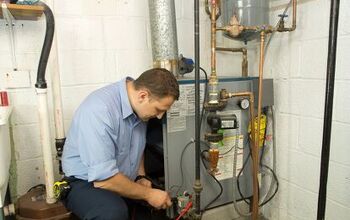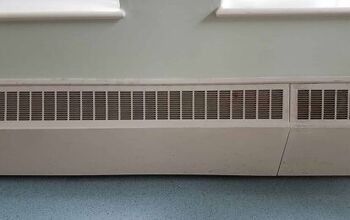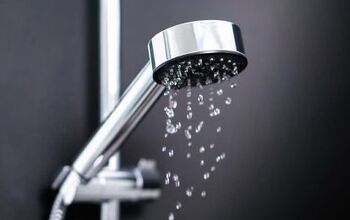Outside Faucet Won't Turn Off? (Possible Causes & Fixes)

The water faucet on the outside of your house can come in handy from time to time. Whether it be watering your flowers, washing your car, or doing a plethora of other hose-related activities, it is a convenience to have that faucet outside.
That is until it stops turning off. When the faucet won’t turn off, you could wind up with a ton of wasted water. More than that, you could be facing elevated water bills in addition to a now-soaked backyard space. The most common reasons are due to a worn washer or an anti-siphon valve. There are a few other things that you can check, too.
Do You Need a Faucet, Fixture, or Pipe Repair or Replacement?
Get free, zero-commitment quotes from pro contractors near you.

Why You Need to Fix That Faucet Issue
Despite the fact that this faucet is located on the outside of your home, there are more than a few reasons why you would want to stop it from randomly flowing water. The most obvious is that it is a huge waste of water, which could jack up your water usage rates in the short term.
On the worst end of the spectrum, you run the risk of water damage to your home. If water is allowed to seep down into the basement or other spaces near the faucet, it could lead to areas of your home being damaged by the water.
Water damage is no joke. Even if you get to the water damage in short order, there is a risk of needing repair or replacement. If you don’t notice the water, then you could also be running the risk of long-term damage. It is a lose-lose situation.
Turn Off the Water Supply First
No matter what the issue may be, the very first thing to do is to cut off the water supply to your faucet. You can’t possibly hope to evaluate the issue if water continues to flow out and soak everything within reach.
Locate your water supply valve and disconnect it from the outside faucet. Most homes have more than one supply water valve. It could be in the garage, basement or might even be closely located to the outside faucet.
Where is My Home’s Shutoff Valve?
It is important to note that your home may not be the same as someone else who is reading this. That said, the most likely place for a shutoff valve is on the inside of the wall that the outdoor faucet is located on.
The shutoff valve is typically right near the ceiling either in a crawl space, a utility room, or a basement. There are also two different kinds of shutoff valve to be aware of. There is the gate valve and the ball valve. The latter tends to be on older faucets in particular.
Why Won’t My Outdoor Faucet Turn Off?
When your outdoor faucet will not turn off, you should cut the water so that you can troubleshoot the issue. There are a few reasons why your outside faucet may not turn off. Some of them are simple and easy to understand, others not so much.
You may have old or worn parts. The washer, in particular, can wear down over time and needs to be replaced in order to properly do its job. It could also be a matter of tightening the faucet-pipe connection or replacing the anti-siphon valve.
Worn Faucet Components
Just like anything else, it is possible for your faucet’s components to simply wear down over time. Even the best of fixtures can and will wear down with time and frequent usage. If your outdoor faucet is older, it is safe to assume that they have just become worn down.
Just because parts are old does not necessarily mean that they need replacing, either. You may be able to simply lubricate some older parts that have stuck in place. That spray lubricant can get them moving once again without the need to replace anything.
Worn Washers
When there is actually a faulty component within your faucet, the most likely explanation is that it is a worn washer. The wash is the airtight seal that prevents water from leaking out of the valve stem when in use.
Pull out the valve stem from the faucet and take a look at the washer. If it shows noticeable wear or damage, replace it. That is likely the source of the issue. The good news is that you can pop it off with a Phillips screwdriver and replace it with a new one in no time at all.
Anti-Siphon Valve
The anti-siphon valve is just that: it prevents water from siphoning out of the faucet. In other words, it protects the drinking water by keeping water from going back through the hose and into your water pipes.
You can unscrew it from the faucet spout and take a look at it. Like the washer, you will be looking for noticeable wear and tear. Should there be damage, replace the anti-siphon valve with a new one. You can simply screw the new one onto the faucet spout in just a few minutes.
Tighten the Faucet-Pipe Connection
More often than not, when water continues to leak it is due to a loose connection somewhere along the line. You can verify that the faucet is tight on the water pipe by using a pipe wrench to tighten the connection between the two.
The only way to do this is if the faucet is screwed onto the pipe. In some cases, it may be soldered. When that happens, then you have to remove the faucet entirely and then reattach it. The good news is that it isn’t nearly as difficult as it sounds.
How to Replace the Outside Water Valve
You may ultimately come to the conclusion that there is no other choice but to replace that water valve. When one or more components have completely worn down over time, it may be more effective to simply replace the entire water valve. Look into the different types of outdoor faucets if yours is beyond repair and needs replacement.
The good news is that the process is relatively simple and straightforward. Here is how to get the job done in short order.
Step 1: Turn the Faucet Shutoff Valve to Closed
Remember that we can’t really do much if the water is still on. Turn your shutoff valve into the closed position before we get going. Then you can comfortably make your change without being soaked to the bones.
Open up the outside faucet all the way so as to relieve any of the pressure that may have been built up in the pipes. When the water flow has completely halted, you are ready to move on to the next step in the process.
Step 2: Loosen the Faucet
Grab an adjustable wrench and use it to loosen the section of your faucet that is right behind the packing nut. Take a minute to familiarize yourself with the location of the components of your faucet first.
Using a second adjustable wrench, clamp down onto the connection between the pipe that runs into the house and the faucet. This is to keep the faucet assembly from spinning as you attempt to loosen it from the pipe.
You can even replace a faucet without turning off the water.
Step 3: Removing the Valve Assembly
Carefully slide the valve assembly completely out of the water pipe. You can do this by pulling on the valve handle directly. Make sure that you remove any of the nuts that are on the valve assembly. You can do that by using a socket or adjustable wrench.
Next, take the washer off of the valve assembly. You can usually pry it up using the head of a flat head screwdriver. Make sure that you unscrew the compression washer from the end of the valve assembly, too. You will need to pry it free, also.
Step 4: Finding the Replacement
Determining the model of valve assembly may be somewhat difficult depending on your level of experience. It is important to get one that matches up properly to your water pipe so as to produce the proper fit.
If you aren’t sure what valve assembly to go with, remove the old one and take it to your local hardware or home improvement store. The team there can help ensure that the valve assembly you replace it with is the right kind and that you have the right washers for the job as well.
Step 5: Replace the Washers and the Assembly
If you want to simply replace the worn washers, that should be fine. If you want to replace the entire assembly, that is certainly fine too. When you are done implementing the replacements, make sure to tighten each of the nuts and screws that you took out of the valve assembly.
Reinsert the valve assembly back into that pipe and then tighten the entire assembly again using your adjustable wrench.
Do You Need a Faucet, Fixture, or Pipe Repair or Replacement?
Get free, zero-commitment quotes from pro contractors near you.

A Final Word
More often than not, the fix to an outdoor faucet that won’t turn off is to replace a worn component. If it isn’t a worn washer, it is typically that the valve assembly will not properly seat against the pipe running from the house.
Check to ensure that all the connections are tight and that none of them have been stripped out. Replace any old components that show significant wear and tear. Check this out If your outdoor faucet only leaks when off.

Ryan Womeldorf has more than a decade of experience writing. He loves to blog about construction, plumbing, and other home topics. Ryan also loves hockey and a lifelong Buffalo sports fan.
More by Ryan Womeldorf

















![12 Washing Machine Brands to Avoid [with Recall Data]](https://cdn-fastly.upgradedhome.com/media/2023/07/31/9075781/12-washing-machine-brands-to-avoid-with-recall-data.jpg?size=350x220)









